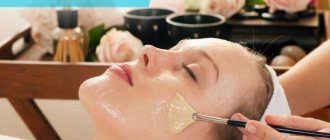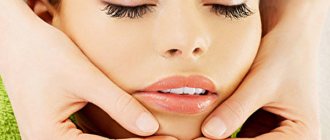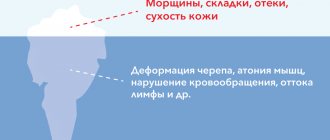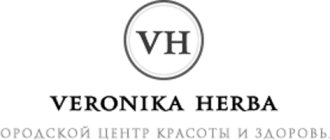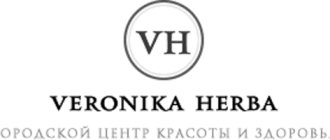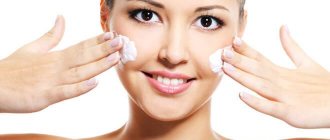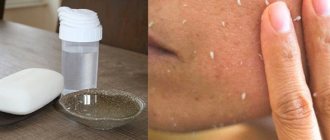What is peeling
Exfoliation (peeling) is a procedure during which dead skin is removed from the facial skin and the surface itself is cleaned. After it, the following consequences may appear:
- peeling - from 2 to 7 days;
- redness (especially after chemical peeling) - up to 5 days;
- slight tingling or burning – up to 2 hours;
- swelling - occurs on thin skin and lasts up to 5 days.
The effect of the procedure is beneficial for the skin, as it starts regeneration processes, activates blood circulation and prevents the appearance of wrinkles. However, peeling is quite harsh, so after the procedure the skin needs to be helped to recover.
Facial massage: skin restoration
How will it help? It will improve local blood circulation, cope with swelling, start the process of tissue regeneration, increase skin tone and prevent premature aging.
When to do it? To achieve the desired rejuvenation effect with manual massage, 10–20 procedures are needed with a frequency of 2–3 times a week, and with hardware massage, one session is enough, which must be repeated twice a year to maintain beauty. Therefore, you should sign up for a manual massage now, while a hardware massage can be done three days before the party.
What to choose? The first thing to consider is your age.
- Lifting massage is a manual technique and is indicated from the age of 25. It can be plasticizing, sculpting, modeling. Each has its own indications, but all of them are mainly anti-aging: combating emerging nasolabial folds, preventing wrinkles and double chin, improving skin tone and elasticity. Lifting massage is done strictly along massage lines, sometimes with the help of oils or wax (sculptural massage). Lifting massage perfectly copes with facial fatigue - one of the first signs of aging. And it will also give you pleasure and complete relaxation.
- Lymphatic drainage massage is a hardware technique indicated for women over 30 years of age. Its advantage is its high efficiency. It is recommended primarily for those who suffer from swelling in the morning and decreased skin turgor. Lymphatic drainage massage can be used both as a prevention of age-related skin changes and as a means of combating them. Unlike manual massage, it affects the deeper layers of the epidermis and allows you to get rid of such signs of aging as emerging nasolabial folds.
How to prepare for peeling
To preserve the effect of the procedure longer, the skin must be prepared:
- Use high-quality skincare products every day - for example, GIGI Bioplasma cream.
- Take a course of vitamins to support your immune system.
- Protect your skin from the sun, using creams with protection level of at least 30. Avoid scrubs and hair removal before the procedure.
- Get rid of acute inflammation so that peeling is not painful.
The deeper the peeling, the more thoroughly you need to prepare the skin. Superficial procedures do not require special preparation.
Laser: getting rid of serious skin imperfections
How will it help? Will remove manifestations of rosacea, age spots, deep wrinkles.
When to do it? To fully enjoy the results, it is advisable to go for the procedure at least three weeks before important events.
What to choose? Lasers are available in non-ablative and ablative types.
- Non-ablative lasers (neodymium laser, phototherapy) do not damage the skin and have a gentle effect on it. Since they act in the deeper layers of the epidermis, they cope perfectly with pronounced wrinkles.
- Ablative lasers (erbium, CO2 laser) damage the skin to stimulate collagen synthesis. The method is effective for correcting fine wrinkles, hyperpigmentation and treating post-acne, as well as rejuvenating the eye and lip area.
General rules of care
Regardless of the type of peeling, after undergoing it, all patients are recommended to do the following:
- For the first 12 hours, it is better not to touch the skin with your hands, not to wash your face or apply any products, and also to avoid exposure to cold wind and direct sunlight.
- For the first 2-3 days after the procedure, it is better to use light, gentle foams and gels for washing. Creams are allowed only on day 3. It is also better to avoid contact with the external environment.
- Two weeks after the procedure, you must strictly follow the cosmetologist’s instructions - take medications, use medicinal care products. It is not recommended to visit baths and saunas or apply decorative cosmetics.
If a crust forms, you should not try to peel it off; it is better to let the skin heal on its own. The most important rule is to avoid infection, so it is recommended to keep the skin clean and not touch it with your hands. When the skin begins to heal, be sure to apply products with a high level of SPF protection before going outside. Not 15, as in standard ones, but 30, or even 50 - GIGI SPF 50 sunscreen would be an excellent option.
What are the contraindications?
The procedure is a type of aggressive effect on the epidermis, so it is not allowed for everyone. Contraindications include:
- stage of exacerbation of infectious, viral, bacterial, fungal processes on the skin;
- unhealed wounds, cuts, abrasions, scratches;
- tendency to form keloid scars;
- tanning 2 weeks or less old;
- chronic diseases in the relapse stage;
- oncological pathologies;
- intolerance to the components of peeling preparations;
- pregnancy and lactation;
- recent laser procedures;
- large moles;
- unstable mental state.
The procedure is not performed if the patient is not feeling well: with fever, pain, high blood pressure, colds, or other ailments.
Care after superficial peeling
At this stage, only the top layer of skin is affected. All unpleasant sensations disappear after 10 days. Formulations with glycolic, malic, tartaric, citric, lactic or phytic acids are used here.
Basics of care after superficial peeling: refrain from contact with water and direct sunlight for 24 hours, avoid touching your face, reduce time spent outside, drink plenty of fluids. You can also use light mousses and foams, and decorative cosmetics can be introduced as early as day 4. For better recovery, it is recommended to use the GIGI Vitamin E mask.
Biorevitalization before laser resurfacing
You can start preparing with biorevitalization. Since during laser resurfacing the skin actively loses moisture and liquid evaporates, it is better to replenish moisture and nutrients in advance. This can be done using biorevitalization.
- The biorevitalization procedure is performed 2 weeks before resurfacing.
Typically, a specialist chooses either a product with pure hyaluronic acid or a composition supplemented with vitamins and other active ingredients. Saturating the skin will help eliminate signs of stress, fatigue, even out color, and remove dark circles.
- Biorevitalizant fills the skin with microelements, amino acids and hyaluronic acid
- Additional hydration is also recommended to replenish deficient conditions in the skin, as well as to accelerate the recovery and regeneration of skin cells after resurfacing.
- As a result, the recovery period is reduced from 14 – 30 days to 7 – 10 days
Combining laser resurfacing with biorevitalization will allow you to get rid of facial wrinkles, signs of post-acne, enlarged pores, and as a pleasant addition, the oval of the face will tighten and become chiseled.
Care after medium peeling
This peeling is prescribed for intense age-related problems or scars. Recovery can take from 5 to 10 days - during this period the skin becomes very red and peels. Care after medium peeling includes:
- limit contact with the external environment for the first 2-3 days;
- do not touch the crusts;
- use mild cleansers;
- Use good sun protection.
It is better to avoid physical activity, visiting baths and saunas, as well as strong cleansers and masks. An excellent option is GIGI Recovery cream, which fights inflammation and helps the skin recover.
Is it possible to go to the bathhouse and play sports after peeling?
If you have exfoliated in a beauty salon, remember an important rule: a bath after peeling is taboo. For the next 48-72 hours after exfoliation of any kind, the skin should not be exposed to elevated temperatures and steam. Not only the traditional Russian steam room is prohibited, but also the Finnish sauna, Turkish hammam, phyto-barrel and other analogues.
Many women are interested in the question “Is it possible to go to the sauna after peeling and why?” In a sauna, as in a bathhouse, body temperature rises and sweating intensifies. Particles of the active substance that was used in chemical exfoliation begin to come out of the pores along with the liquid. At the same time, the effect of the procedure is noticeably reduced. In addition to increased sweating, during a stay in a sauna or bathhouse, a person’s blood vessels dilate and the skin turns red. This process prolongs the hyperemia of the skin for a longer period of time. Therefore, when a patient asks a cosmetologist, “Is it possible to go to the steam room or bathhouse after peeling?”, the specialists answer with a firm “no.”
A specialist in outdoor activities will give approximately the same recommendations. Can I exercise after peeling? You will hear an unequivocal “no!” from experts. Active sports also provoke sweating and redness of the surface layer of the skin. This interferes with the normal process of restoration of the epidermis after injury. During the rehabilitation period, I need to refrain from baths and fitness.
Now you know the answer to the question: “Can I take a bath or go to the gym after peeling?” To quickly restore the skin and consolidate a good result, these activities should be abandoned. Spicy foods and alcohol, which cause vasodilation, are also prohibited.
Care after deep peeling
Deep peeling with chemicals is a difficult medical procedure, which is performed exclusively for indications: for large scars and significant scars, to eliminate age-related problems or stretch marks. Care after such a procedure includes the following:
- limit contact with the external environment as much as possible - do not go outside again, do not touch your face with your hands;
- use only soft care products, such as foam;
- Do not use decorative cosmetics until the skin is completely healed.
After such a procedure, the skin’s protective barrier weakens, so the body is easily susceptible to diseases. Deep peeling is contraindicated in the following cases: chronic diseases, the entire period of pregnancy and lactation, diseases of the gastrointestinal tract, endocrine and cardiovascular systems. To reduce the likelihood of skin infection, your doctor may prescribe antibacterial agents and pain relievers.
Plasma therapy + laser resurfacing
We recommend combining laser therapy with plasma therapy for owners of problematic skin prone to inflammation and signs of post-acne. With this combination of procedures, you will get smooth, beautiful skin, the texture of which is very different from the original one.
- The plasma is filled with a special component that minimizes the recovery period.
- After the procedure, patients are less likely to experience skin swelling and pain.
- The rehabilitation and healing process is significantly accelerated.
As a result, deep processes of creating new connective tissue are launched, and post-acne scars straighten out on their own from the dermis.

